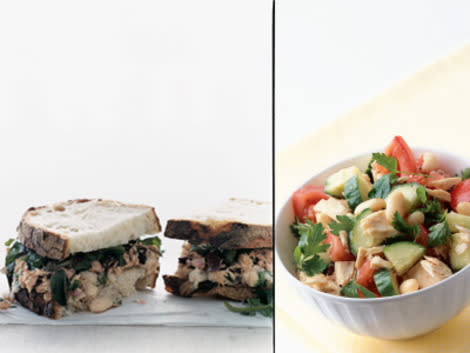10 Ways to Boost Your Omega-3s for Heart Health
For American Heart Month, be kind to your heart with our delicious heart-healthy recipes and expert nutrition tips
by Megan O. Steintrager
February is American Heart Month, so now's the ideal time to think about prevention and take steps to reduce risk factors for heart disease, the leading cause of death in the United States, according to the Centers for Disease Control. To help control your blood pressure and cholesterol, lifestyle changes, which include exercising regularly and maintaining a healthy weight, are crucial to long-term success. Eating smart is also key, and for many of us, that includes cutting down on sodium, saturated fat, trans fats, and sugar. Yet for this month's Doable Challenge, we're focusing on adding something to our diets: more omega-3 fatty acids.
Omega-3s are a type of essential fatty acid--"essential" because our bodies need them to function properly--and since the body cannot produce enough of them, we must get them from our food. Plant sources such as nuts provide one type, alpha-linolenic acid (ALA), while fish and seafood (and algae) are sources of eicosapentaenoic acid (EPA) and docosahexaenoic acid (DHA). Most Americans don't consume enough omega-3s of any type, thus the best bet for heart health and overall well-being is to pump up your diet with all three.
You've likely heard about the myriad health benefits of omega-3 fatty acids. These naturally occurring polyunsaturated fats have been credited with helping burn body fat more effectively. Studies suggest they might also help make skin supple and smooth, fight depression, and keep the mind sharp. But omega-3 fatty acids have been particularly strongly linked to improved heart health.
According to the American Heart Association (AHA), research indicates that omega-3s reduce triglyceride levels; decrease risk for abnormal heartbeats; slow the growth rate of plaque in the heart's arteries; and can slightly lower blood pressure. "Population studies have shown that plant omega-3s and marine omega-3s are protective against heart disease," confirms Penny M. Kris-Etherton, Ph.D., R.D., a distinguished professor of nutrition at Penn State University and a spokesperson for the AHA. Read on for the ABCs of this good fat, including the best sources and numerous omega-3-rich recipes for breakfast, lunch, dinner, and snacks.
Nosh on Nuts and More
When it comes to the plant-based omega-3 ALA, Kris-Etherton advises following the National Academies' Dietary Reference Intakes guide, which is easy enough when you consider that just 1 ounce of walnuts provides more than the recommended amount of 1.6 grams a day of ALA for men and 1.1 grams for women. Flaxseeds pack even more ALA than walnuts; just make sure you are consuming flax in the form of flax oil or ground flaxseed (slightly nutty and grassy-tasting) for optimized nutritional value, since whole flaxseeds pass through the body undigested. Other good sources of ALA are canola oil and soy (including edamame, tofu, and soybean oil). Another option that's trendy now: mild and nutty chia seeds, recommended by doctors Mehmet Oz and Michael F. Roizen.
Here are six easy and delicious ways to incorporate these omega-3-rich foods:
1. Top cereal and yogurt with walnuts and ground flax (also called "flax meal")
2. Cook with canola or soybean oil
3. Use ground flax as a vegan substitute for eggs when baking (1 tablespoon of flax powder to 3 tablespoons of water per egg)
4. Use walnut oil in place of olive oil in vinaigrettes
5.Replace bread crumbs with flaxseed meal for gratins and meatballs that are gluten-free
6. Mix flaxseed oil with nut butters for an omega-3-enhanced spread.
Say "Yes" to Seafood
While Kris-Etherton says all omega-3s are beneficial, "omega-3s from fish have remarkable cardioprotective effects." She notes that the government's latest (2010) U.S. Dietary Guidelines recommend 250 milligrams per day of seafood-based omega-3s EPA and DHA, which is the equivalent of two servings of seafood per week. Americans typically eat only one serving each week, so "on a population basis, we need to double seafood consumption to meet the current recommendation."
Choose Heart-Smart Fish
According to Kris-Etherton, fatty fish such as salmon, tuna, and anchovies are good sources of EPA and DHA. Other fish with significant amounts of these omega-3s are freshwater trout, herring, shad, Atlantic and Pacific mackerel, and sardines. If shopping for fresh fish is hard to fit into your routine, keep frozen fillets in your freezer and cans of sardines and other fatty fish on hand for easy and nutritious last-minute meals. And remember, with every serving of seafood, you're also getting high-quality protein--without the large amounts of saturated fat many meaty proteins deliver.
A note about mercury: The American Heart Association advises children, women who are planning to become pregnant, pregnant women, and nursing mothers to steer clear of certain seafood--specifically, shark, swordfish, king mackerel, and tilefish--due to very high levels of mercury.
Look at the Big Picture
In addition to increasing your omega-3 intake, try consuming other heart-smart foods. "Follow the AHA dietary recommendations," Kris-Etherton advises. "Eat more fruits and vegetables, fish, and fiber-rich whole grains, less sodium, and less added sugar."
Those are wise words to eat by, and you'll find plenty of healthy recipes to try here on Epicurious. Get started today with one of the recommended recipes, and you'll find this month's Doable Challenge is even easier done than said (that's "eye-cosa-penta-ee-no-ic" acid, by the way)!
More from Epicurious:
Essential Tools for Portion Control
5 Most Common Recipe Mistakes People Make

